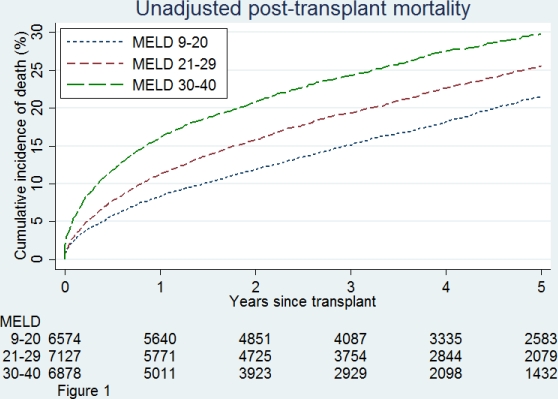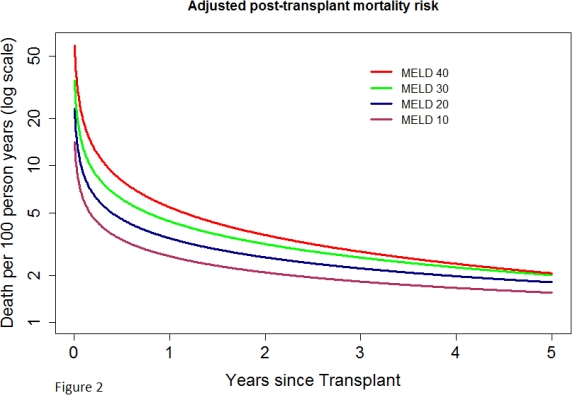MELD as a Predictor of Post-Transplant Survival
Department of Surgery, Johns Hopkins, Baltimore.
Meeting: 2015 American Transplant Congress
Abstract number: C102
Keywords: Liver transplantation, Survival
Session Information
Session Name: Poster Session C: Liver Donation and Allocation
Session Type: Poster Session
Date: Monday, May 4, 2015
Session Time: 5:30pm-6:30pm
 Presentation Time: 5:30pm-6:30pm
Presentation Time: 5:30pm-6:30pm
Location: Exhibit Hall E
MELD is a reliable tool to predict liver waitlist mortality. Previous studies of MELD and post-transplant outcomes have had conflicting results.
METHODS: We used generalized gamma regression and SRTR data 2006-2013 to explore the association between MELD at transplant and post-transplant survival, adjusting for donor, recipient and graft characteristics. Pediatric patients, multi-organ recipients, exception patients, Status 1 patients, and patients with MELD<9 were excluded.
RESULTS: Of 20,579 eligible recipients, unadjusted 5-year patient survival was 21.5%, 25.6%, and 29.7% among MELD 9-20, 21-29, and 30-40, respectively (Figure 1).

After adjustment, mortality risk was highest just after transplant and dropped down dramatically within the first year (Figure 2). After first year, mortality risk attenuated over time.

Compared to MELD 15, the adjusted relative hazard (aRH) was highest just after transplant and attenuated over time (Table 1). For example, at MELD 25, aRH was 1.37 1.54 1.78 just after transplant, but 1.06 1.20 1.32 three years post-transplant. At 5 years post-transplant, aRH was non-significant.
| At transplant | 1 year | 3 years | 5 years | |
| MELD 15 | Reference | Reference | Reference | Reference |
| MELD 20 | 1.18 1.25 1.36 | 1.09 1.14 1.18 | 1.04 1.10 1.15 | 1.00 1.07 1.13 |
| MELD 25 | 1.37 1.54 1.78 | 1.18 1.29 1.40 | 1.06 1.20 1.32 | 0.99 1.14 1.27 |
| MELD 30 | 1.60 1.90 2.30 | 1.26 1.46 1.67 | 1.06 1.29 1.50 | 0.96 1.19 1.42 |
| MELD 35 | 1.94 2.42 3.00 | 1.32 1.64 1.98 | 1.04 1.36 1.70 | 0.91 1.22 1.56 |
| MELD 40 | 2.48 3.17 4.07 | 1.36 1.80 2.31 | 1.00 1.40 1.87 | 0.85 1.23 1.67 |
CONCLUSIONS: Higher MELD at transplant conferred greater risk of post-transplant mortality which attenuated over time and became non-significant after 5 years.
To cite this abstract in AMA style:
Luo X, Massie A, Poon A, Segev D. MELD as a Predictor of Post-Transplant Survival [abstract]. Am J Transplant. 2015; 15 (suppl 3). https://atcmeetingabstracts.com/abstract/meld-as-a-predictor-of-post-transplant-survival/. Accessed December 14, 2025.« Back to 2015 American Transplant Congress
